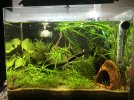whnighswonger
New Member
- Messages
- 5
Hey guys so i had 2 apistos cacatuoides in a 10 gallon a male orng flash and female dbl red.
They were healthy eating flirting (not spawning, cant find the right apisto cave at my LFS gotta order/make one) but regardless they were thriving for months.
2 weeks ago my female started acting lethargic but she was eating and eager to eat, and then i found her dead about a week after i noticed her symptoms she died, i didnt think much of it because she was eating a bunch.
Now fast forward two weeks, i notice a big cut in his tail fin (possibly from flirting near the wood or plants my guess) and he started acting lethargic. Then he stopped eating, he used to come up to and eat from my tweezers when i fed bloodworms...
Anyways he stopped eating but looked SUPER bloated, like he just chowed down.
Couple days later he died
Water parameters are good...
Ph: 6.5-6.8
Ammonia: 0
Nitrite: 0
Nitrate: >20
any advice would help
Tank also has
7 pygmy corys
4 otos
5 ember tetras
Heavily planted tank too
They were healthy eating flirting (not spawning, cant find the right apisto cave at my LFS gotta order/make one) but regardless they were thriving for months.
2 weeks ago my female started acting lethargic but she was eating and eager to eat, and then i found her dead about a week after i noticed her symptoms she died, i didnt think much of it because she was eating a bunch.
Now fast forward two weeks, i notice a big cut in his tail fin (possibly from flirting near the wood or plants my guess) and he started acting lethargic. Then he stopped eating, he used to come up to and eat from my tweezers when i fed bloodworms...
Anyways he stopped eating but looked SUPER bloated, like he just chowed down.
Couple days later he died
Water parameters are good...
Ph: 6.5-6.8
Ammonia: 0
Nitrite: 0
Nitrate: >20
any advice would help
Tank also has
7 pygmy corys
4 otos
5 ember tetras
Heavily planted tank too
